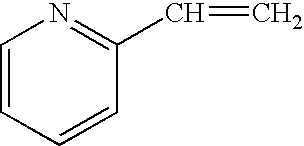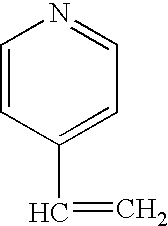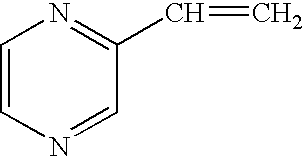Process for making light weight rubber composition containing clay
a technology of composition and rubber, which is applied in the direction of special tyres, rolling resistance optimization, transportation and packaging, etc., can solve the problems of difficult to improve the traction characteristics of tires without compromising rolling, blends with low glass transition temperature and high glass transition temperature rubbers exhibit poor processability, etc., to achieve the effect of reducing the weight of rubber articles, reducing weight, and reducing weigh
- Summary
- Abstract
- Description
- Claims
- Application Information
AI Technical Summary
Benefits of technology
Problems solved by technology
Method used
Image
Examples
example 1
[0067]In this experiment, a block polymer, containing 2 percent 2-vinylpyridine by weight was prepared. In the procedure used, 2330 g of a silica / alumina / molecular sieve dried premix containing 21.0 weight percent styrene and 1,3-butadiene in hexanes was charged into a one-gallon (3.8 liters) reactor. The ratio of styrene to 1,3-butadiene was 23:77. 4.1 ml of 1M solution of N,N,N′,N′-tetramethylethylene diamine (TMEDA) in hexanes and 2.0 ml of 1.03 M solution of n-butyllithium (n-BuLi) were added to the reactor to initiate the polymerization. The molar ratio of TMEDA to n-BuLi was 2:1 and the target number average molecular weight (Mn) was 240,000.
[0068]The polymerization was carried out at 75° C. for 90 minutes. The GC analysis of the residual monomer contained in the polymerization mixture indicated that the polymerization was complete at this time. The polymerization mixture was cooled to 40° C. Freshly distilled 2-vinylpyridine (9.8 grams) was then added to the reactor and the ...
example 2
[0070]The procedure described in Example 1 was utilized in these examples except that the number average molecular weight (Mn) of the 23 / 77 SBR was targeted at 200,000. The glass transition temperatures (Tg) and Mooney ML-4 viscosities of the resulting polybutadienes were determined to be −29° C. and 100, respectively.
example 3
[0071]In this example, a pyridine end functionalized 15 / 85 SBR was prepared. In the procedure used, 2320 g of a silica / alumina / molecular sieve dried premix containing 21.0 weight percent styrene and 1,3-butadiene in hexanes solvent was charged into a one-gallon (3.8 liters) reactor. The ratio of styrene to 1,3-butadiene was 15:85. Then, 1.1 ml of neat N,N,N′,N′-tetramethylethylene diamine (TMEDA) and 6.8 ml of 1.03 M solution of n-butyllithium (n-BuLi) in were added to the reactor to initiate the polymerization. The molar ratio of TMEDA to n-BuLi was 1:1 and the target number average molecular weight (Mn) was 70,000.
[0072]The polymerization was carried out at 70° C. for 60 minutes. The GC analysis of the residual monomer contained in the polymerization mixture indicated that the polymerization was complete at this time. Then, 7.0 ml of 1 M pyridine solution in hexane was added to the reactor and the reaction was continued at 70° C. for 30 minutes and then 7.5 ml of 1M ethanol solut...
PUM
| Property | Measurement | Unit |
|---|---|---|
| temperature | aaaaa | aaaaa |
| weight percent | aaaaa | aaaaa |
| temperature | aaaaa | aaaaa |
Abstract
Description
Claims
Application Information
 Login to View More
Login to View More - R&D
- Intellectual Property
- Life Sciences
- Materials
- Tech Scout
- Unparalleled Data Quality
- Higher Quality Content
- 60% Fewer Hallucinations
Browse by: Latest US Patents, China's latest patents, Technical Efficacy Thesaurus, Application Domain, Technology Topic, Popular Technical Reports.
© 2025 PatSnap. All rights reserved.Legal|Privacy policy|Modern Slavery Act Transparency Statement|Sitemap|About US| Contact US: help@patsnap.com



